





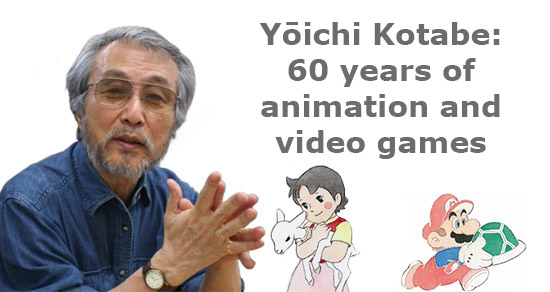
Table of contents :
Part I: The Tōei era
Part II: From one studio to another
Part III: From animation to Nintendo
Part IV: Diversification and transmission
Part V: Towards new horizons
Sources
Appendix : Works on which Yōichi Kotabe has worked
"At the time, my wife Reiko Okuyama was working on the animation of the film. Among the shots she was in charge of, there was the whole scene that takes place on the beach, so at the water's edge. So I decided to help her out and animated the waves in particular. But this is something that was never announced at the time and my name does not appear in the credits. Well, now it's not a secret anymore (laughs), even though I didn't do this during my working hours at Nintendo, but at night, when I got home. This has caused me some health problems again..."

One of the many maritime scenes animated by Kotabe
Nintendo's policy on the subject of working outside the company is now known since composer Hirokazu Tanaka made it clear in an interview: "Nintendo didn't allow employees to work for other companies." However, it seems that this prohibition was not absolute, but rather concerned work on commercial works produced without Nintendo's approval (several prominent members of Nintendo have been allowed to teach game design or animation courses in schools in parallel with their work as video game developers), which did not prevent Kotabe from lending Okuyama assistance. Moreover, the help in question was not given in a totally spontaneous way, Kotabe having indicated a few years later that it was Takahata himself who had asked Okuyama to work with her husband.
Grave of the Fireflies marks the only collaboration between Kotabe and Studio Ghibli. However, he and others close to the studio tried to set up a video game project involving both Nintendo and Ghibli.
"Once, together with Mr. Ikeda and Shigesato Itoi, the famous advertising slogan writer who wrote the slogans for the Ghibli films, among other things, we went to see Mr. Miyazaki to propose that we work together on a video game for Nintendo. Contrary to what you might think, he didn't say no. He told us that he would be interested in making a video game that takes place in the world of insects, where the player would see the world through the eyes of one of them. But it didn't happen, he was busy.
Since the adaptations of Nausicaä on Japanese computers, no film of Miyazaki has been adapted into a video game. The director was approached by Tokuma Shoten (of which Ghibli was a subsidiary at the time) with a view to adapting My Neighbor Totoro for the Super Famicom, but he did not give his approval.
Although Kotabe has indicated that he made the cover illustrations for the Mario games, it seems necessary to us to qualify this statement. In addition to the question of the incomplete credits implying that these illustrations were probably made by several people, we notice that he probably did not illustrate some of the titles developed before the advent of 3D illustrations (which coincides with the releases of Super Mario RPG and Super Mario 64 in 1996). For example, All Night Nippon Super Mario Bros. (December 1986), an alternate version of Super Mario Bros. in which Bowser still looks like his old self, even though he had been redesigned by Kotabe a few months earlier in Super Mario Bros. 2. As for Super Mario Bros. & Friends - When I grow up (1992), a title released on DOS and developed outside of Nintendo's studios, it was not Kotabe but Rick Incrocci who was credited as illustrator. What's more, it happened that it was Shigeru Miyamoto who illustrated the cover of some official game guides, published by his friend Shigesato Itoi's company.
It is highly likely that the former Tōei employee did illustrations for most of the Famicom era games after Super Mario Bros. and featuring the plumber, from Super Mario Bros. 2 (1986) to Famicom Golf (1987) to Famicom Grand Prix (1987-88). However, there is no doubt about Super Mario Bros. 3 and its sequel, Super Mario World. For the Super Mario Bros. 3 (1988) manual, Kotabe created a number of watercolor illustrations which - remarkably - have remained in his possession in whole or in part and have since been included in a collection of drawings and exhibited to the public.
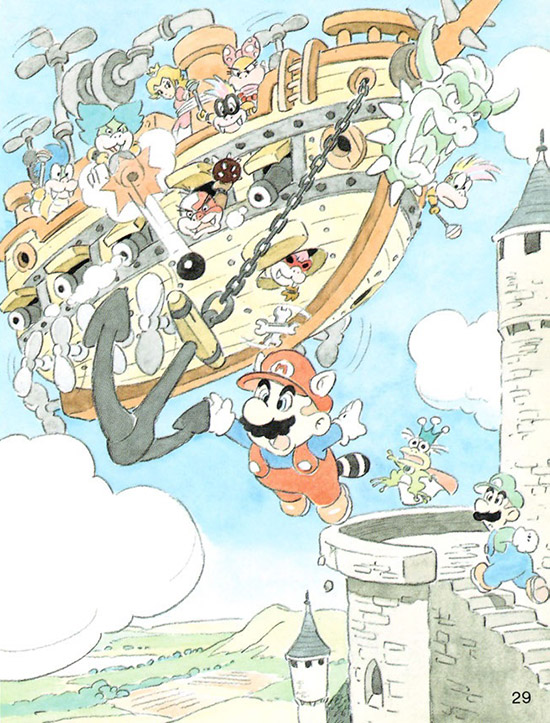
Watercolor illustrations made for the game's manual
Concerning Super Mario World (1990), his contribution is as much about character design as it is about game design, according to his testimony. Even during the development of Super Mario Bros. 3 for the Famicom, Miyamoto and his team had the idea of giving their character a mount, something that the console's capabilities did not allow them to accomplish. As for what path led the developers from the idea of a horse to the idea of Yoshi, Kotabe has a little idea:
"At the time, I never had a direct say in the characters' movements in the game. I used to scribble down a lot of things that I thought were interesting for games and hand them over to the developers. Once I thought it would be fun to have an animal like this, so I drew a chameleon looking sideways and sticking its tongue out to catch something. This move was then adopted for Yoshi, who sticks his tongue out to eat something. This is just a guess, I didn't really check, but I'm sure they adopted the idea I had at the time.
I didn't ask them to put it in permanently, but sometimes I've sketched an idea and before I knew it, it was in the game.
The name Yoshi (Yossy in the Japanese version) is derived from the nickname of a female employee named Yoshimura and the dinosaur Nessie, which is said to have lived in Loch Ness.
At first I thought he was a dinosaur and kept drawing pictures of him, but later I was told that he was actually a character from the same turtle family as Bowser. So, over time, Yoshi's design became more and more turtle-like."
Note that some of the drawings made by Kotabe were not drawn on paper but through a Famicom.
"What I remember about the Disk System is that we could save our drawings on a disk and take them to Kyōto, or send them by mail. Since it was an old computer, it was pixel drawings. I used to draw simple animals and birds, add movement to them, and take them to Kyōto."
"I started playing around with and piecing together animations of animals (horses running, eagles flying, etc.). I made several, including one of a chameleon throwing its tongue."
Since the release of Super Mario Bros. in 1985, the series has been so successful that a plethora of derivative products have been created. While Kotabe usually acted as a supervisor, making sure that his character designs were respected and pointing out any corrections that needed to be made, he sometimes picked up his pencil to contribute more directly to certain products. For example, he created a small animation for the needs of a Laserdisc related to Super Mario World and to which contributed a certain Satoshi Tajiri, future co-creator of Pokémon. We also owe him a comic strip made for the official guide of the game Yoshi's Cookie / Yoshi no Tamago, published in 1992 and edited once again by Shigesato Itoi 's publishing house.
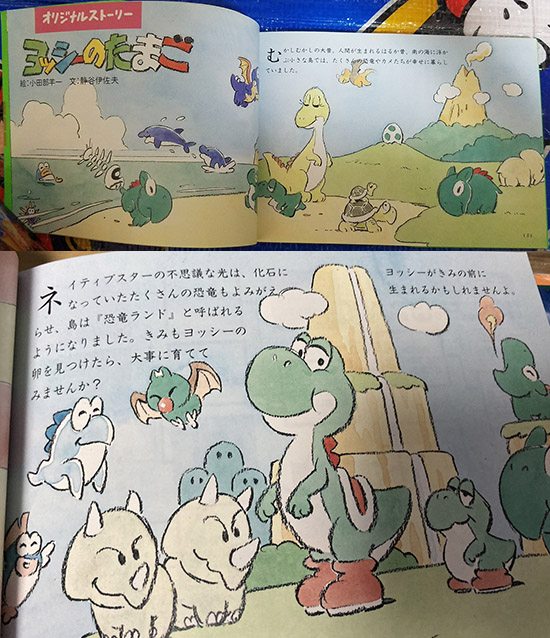
Illustrations created for Yoshi no Tamago - Nintendo Kōshiki Guide Book
In addition to his work as an illustrator, character designer, and animator, Kotabe was given the task of passing on his skills by training new artists within Nintendo, even going so far as to participate in the job interview of at least one of them: Yoshiaki Koizumi, future director of Super Mario Galaxy.
Koizumi: "I joined Nintendo in 1991, the year after Super Mario World was released. I wasn't hired to create games, I was in charge of drawing illustrations for game covers and instruction manuals. Mr. Yōichi Kotabe taught me how to draw characters and I started drawing Mario every day. He told me things like 'The lines for Mario are about this thick' and 'This line is two millimeters. The space between these eyes is one millimeter.'
Koizumi: The first person I worked with after I joined the company was Mr. Kotabe.
Kotabe: Mr. Miyamoto told me that you had to continue working as a character illustrator for a while.
Miyamoto: I told him to develop Mr. Koizumi's skills.
From the early 1990s, Kotabe co-directed or even supervised the illustrations for various games with Koizumi and other in-house artists, from The Legend of Zelda: A Link to the Past and Link's Awakening to Super Mario Kart. On the latter, his training work went up another notch by embracing a maxim taught at Tōei, leading the development team to do a session in real karts:
"At Tōei Animation, they always said, 'Observe the real world,' so I insisted on releasing a budget to do it."
At the same time, he enjoined Koizumi to to accompany them to collect references for the illustrations he was to make for the game.
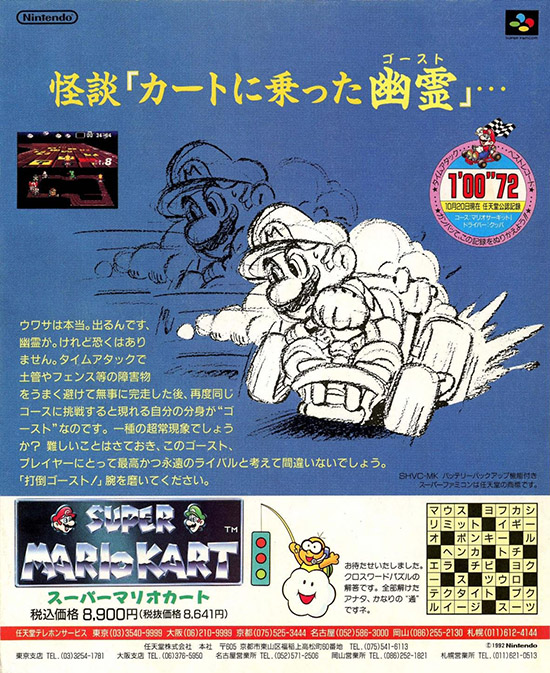
Advertising illustrated by Kotabe for the game Super Mario Kart. His pencil drawing is also featured on the cover of the official game guide.
When he joined Nintendo in 1985, Kotabe already had a few months of experience as a teacher. In the spring of that year, he joined the animation department of Tokyo Design College, where he taught animation technique along with others of his peers, such as Yasuji Mori and Reiko Okuyama. In fact, Kotabe has never totally abandoned animation, participating as a jury member in the ICAF (International College Animation Festival), speaking at conferences, teaching courses at the Tōei Animation Institute as early as 2007 or leading a master class at the Forum des images in Paris in 2003 (during which one of the exercises consisted of animating waves).
As a teacher or supervisor, Kotabe is the kind of person who sees the glass as half full, even if his method has sometimes been destabilizing.
"Someone at Nintendo said to me, 'Mr. Kotabe, you give me compliments, but then you always find something to complain about' (laughs). I wasn't aware of that at all. I naturally look at the good points and compliment them, but I still have to talk about the more questionable points."
Throughout the 1990s, Kotabe continued to refine characters newly introduced into the Mario universe as well as old ones, whether it was Donkey Kong (presumably for the Game Boy episode released the same year as Donkey Kong Country, in 1994) or Wario.
"I helped define Wario's design. His designers had an evil Mario doppelganger in mind, so I drew him with the image of Brutus in mind, Popeye's enemy, and the image of Pinocchio's circus owner, to accentuate his evilness."
But one of his most important contributions in terms of redesign was, once again, Mario, who made his transition into a 3D world with the release of Super Mario 64 in 1996. We often associate 3D animation with motion capture, but we forget that many games, especially in the platform genre, do not feature human characters or characters with realistic proportions. So it is with our plumber, who is more like a cartoon character like Elmer Fudd than a tall, dark-haired man with a three-day beard. Moreover, Miyamoto felt that realistic gestures with perfectly decomposed animation would imply a longer reaction time, so he chose an animation that would limit this delay as much as possible and reinforce the player's control.
Kotabe, as an experienced designer and animator, is trained to visualize in volume what he has to draw and thus seemed to be the perfect choice to assist the developers in modeling their characters. However, he was not spontaneously called in on this job and it was up to him to offer his help to the team members and more particularly to Yoshiaki Koizumi, who was in charge of modeling and animating Mario and who apparently intended to do it on his own..
The way a character is modeled has a direct influence on their gestures. Unless collisions between body parts are ignored, a character with a large head will not be able to lift their arms in the same way as a character with more realistic proportions. The designers can't cheat as easily as in 2D, where you can easily hide this or that body part.
"In his pixel version, Mario is two heads high. But when it came time to adapt it to 3D, the developers said, 'Mr. Kotabe, this doesn't work,' and they made Mario's body longer. But I wanted to make sure that I didn't alter the look that the character had in the 2D era, both in pixel art and in illustration. So I drew him in 3 dimensions from different angles."
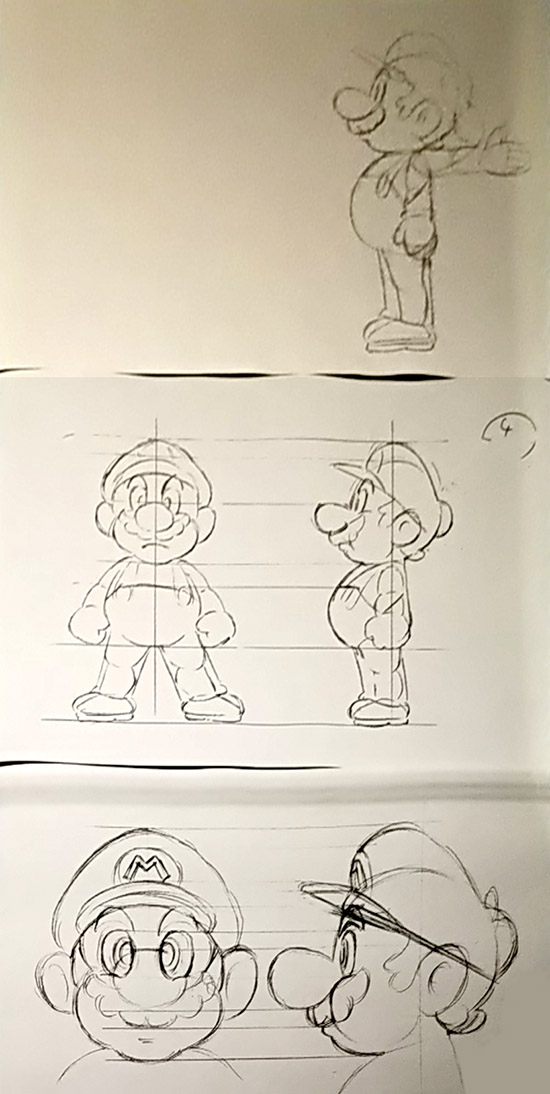
Drawings laying the foundations of Mario's design in Super Mario 64
Kotabe reduced the size of the plumber's head from the paper stage and then asked if he could learn to use the modeling software used by the development team. After all, who better than himself to transcribe his vision? But that's forgetting that, although he was an employee of a video game company, he was not exactly perceived as a video game developer within the company. Far from being a handicap, this allowed him to bring an external viewpoint, to freely express his opinion and to propose solutions that would not have seemed logical to a developer who was aware of the limitations of the machine or the engine they were working on.
He was thus welcomed into the team and supervised the modeling of the characters.
"We did tests with the 3D camera, angle by angle, looking at what needed to be changed. It was a meticulous work of correction.
We worked on all possible scenarios. If we take off Mario's hat, what's underneath? What if he's naked? What if he gets angry? What if he's acting stupid?
"For Mario, I would spin the model around and give instructions like a sculptor, like, 'Cut this part' or 'Round this one.' (For Peach) I would ask them to round the cheeks like this, and when the lips got too thin, I would tell them to make them fuller and softer. For the eyes, I would tell them to raise the lower lids a little bit."
Super Mario 64 is not the first commercialized game for which a 3D version of Mario was produced. A few months before that, Super Mario RPG was released, a title developed by Square that featured characters modeled in 3D and then converted into sprites. Even then, Kotabe was already reviewing Nintendo characters in third-party video game productions.
"When Square and Camelot (Mario Golf, Mario Tennis) incorporated Nintendo characters into their games, I had to make sure they were consistent and that the graphics were consistent."
With the advent of 3D, Kotabe became the person in charge of making sure that the 3D models of characters that are Nintendo's intellectual property (in part or in whole) meet the established standards. In addition to the aforementioned titles, he was also the supervisor for the Mario Party and Super Smash Bros. series, as well as for Pokémon Snap and the two Pokémon Stadium games, where he closely supervised the character modeling, as he had done on Super Mario 64.
Released a few months before Super Mario 64, Pokémon was the phenomenom that no one expected, boosting sales of a Game Boy that was at the end of its life and quickly spreading beyond the video game field.
"The Pokemon games were so popular that a company wanted to make an animated adaptation of it.
At the time, I was the only one who knew anything about animation, so they asked me to attend a meeting. If Mr. Ikeda had been there, he would have said something like, 'It's such a difficult job to do animation,' and the project might have been rejected. But because I am a carefree and easy-going person, I said at the meeting, 'If you are determined, that's fine,' and the film was approved.
Because of my position, I became the animation supervisor for Pokemon. Because the words 'supervisor' and 'director' have similar letters, people sometimes thought that I was the director (laughs). (note: unlike an animation director, an animation supervisor does not check every drawing)
Many people also told me that Pikachu's cuteness resembled the squirrel character (Chiro) I drew in Horus, Prince of the Sun, and that his red cheeks came from Heidi. ...... Even Hayao Miyazaki said, 'Mr. Kotabe must have drawn him! He looks like Chiro!' (laughs). I had to say no to every single one of them."
"Actually, it's a happy misunderstanding: the original idea came from Ken Sugimori, a designer at Game Freak, the company that created the game. Mr. Sugimori is also an animation fan and used to watch Marco."
Pokémon is a license co-owned by three companies including Nintendo and Game Freak. The latter two had already collaborated a few years earlier on the game Mario & Wario (1993), which featured Kotabe's name in the end credits. He saw at least one advantage in working on the animated adaptation of Pokémon: the production was done in the city where he lived. Secondly, he got preferential treatment from Game Freak.
"When the animated adaptation project started, one of the requirements was that we had to have played the game, but I got an exemption because of my age."
Kotabe oversaw nearly 50 Pokémon-related films, TV movies and series from 1997 to 2016, but never designed a character for the license. He did, however, create an official illustration for its trading card game in 2009.
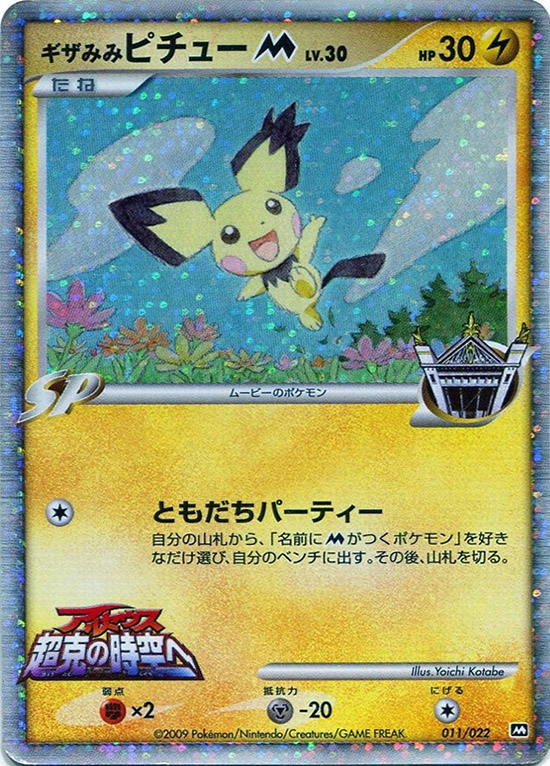
Pichu illustrated by Kotabe
Some titles remain in the draft stage for years because of the lack of ideal conditions for their production; Kuru Kuru Kururin was one of them. Evolution of the arcade game The Irritating Maze, itself a descendant of Marble Madness, the game developed by Eighting clearly shows the origins of its creator, which until then was rather used to game centers but which, wanting to produce more accessible games, preferred to turn to consoles. The Game Boy Color and the Nintendo 64 were then on the market, but the technical capabilities of the former made it difficult to develop the game and the selling price of the latter's cartridges did not really correspond to the type of game the company wanted to produce. So the Game Boy Advance came along at the right time, providing a solution to both of these problems. Nintendo was charmed by the project and decided to produce it using some of its employees, including Hiroshi Sato, who took on the role of producer.
Hiroshi Sato : "There's a character supervisor at Nintendo named Yōichi Kotabe [...] and it's been a long time since he drew a character for me. Most of the characters he drew were cute, like bunnies and squirrels, but Kururin was the only one that stood out for me. So I immediately went for that character."
Kotabe : "I was asked to create a character for the game. The main character, Kururin, was imagined as a starship pilot. He's a bird-like animal, and he has a father and mother. What was interesting was that the director had the idea of giving each of the children a color of the rainbow. I was very impressed with that idea. I used to draw with one color, just one line."
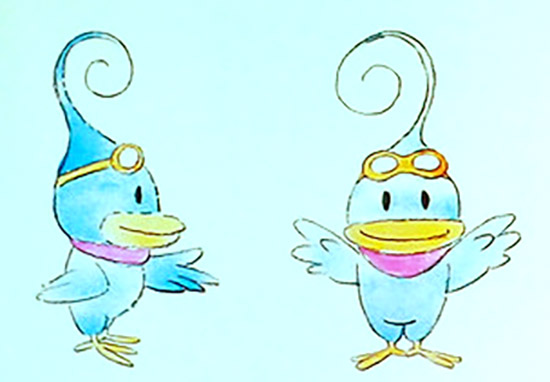
The main character of the game Kuru Kuru Kururin drawn by Kotabe
Kuru Kuru Kururin was a launch game for the Game Boy Advance and had two sequels released in the early 2000s. It is one of the last, if not the last, work of Kotabe as a character designer at Nintendo, as he mainly worked as a supervisor of character design or illustrations in the 2000s.